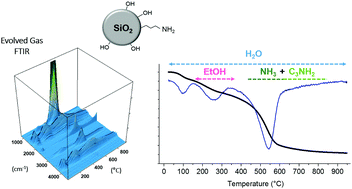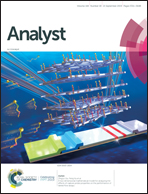Quantification of surface functional groups on silica nanoparticles: comparison of thermogravimetric analysis and quantitative NMR†
Abstract
Thermogravimetric analysis (TGA) coupled with evolved gas analysis-FT-IR has been examined as a potential method to study the functional group content for surface modified silica nanoparticles. A comparison with a quantitative solution NMR method based on analysis of groups released after dissolution of the silica matrix is used to provide benchmark data for comparison and to assess the utility and limitations of TGA. This study focused primarily on commercially available silicas and tested whether it was possible to use a correction based on bare silica to account for the significant mass loss that occurs due to condensation of surface hydroxyl groups and loss of matrix-entrapped components at temperatures above ∼200 °C. Although this approach has been used successfully in the literature for in-house prepared samples, it was problematic for commercial silicas prepared by the Stöber method. For these materials the agreement between estimates from qNMR and TGA mass loss was poor in many cases. However much better agreement was observed for samples for which the mass loss above 200 °C is relatively low, such as non-porous silica, or samples for which the mass fraction of functional group is large (e.g., high molecule weight groups or multilayers). FT-IR was useful in identifying the likely structure of the components lost from the surface at various temperatures and in some cases provided evidence of contaminants in the sample. Nevertheless, in other cases correlation of thermograms and FT-IR with NMR data was necessary, particularly for samples where multi-step modification of the silica surface results in incomplete functionalization that gives a mixture of products. Overall the results indicate that TGA provides reliable results for silicas of low porosity or those for which the functional group accounts for a significant fraction of the total sample mass. It is also suitable as a supplementary or screening technique to indicate the presence of coatings or covalent surface modification, prior to applying other techniques or for routine analyses where sensitivity is not critical.



 Please wait while we load your content...
Please wait while we load your content...